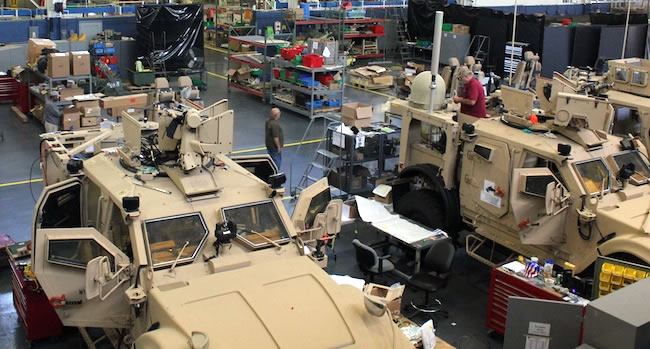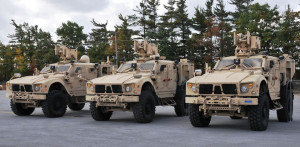

In October 2012 the US Army embarked on an ambitious upgrade of its tactical command and control system, introducing new radios, networking and satellite communications systems to modernize the command and control layers of its infantry brigade combat teams. The new equipment is fielded through a broad modernization process implemented throughout the brigade and its subordinate units, in ‘Capability Set’ delivered and installed with brigade combat teams, through all their command elements and subordinate units. The current upgrades implemented in the CS 13 phase addresses 11 critical areas outlined in ‘Operational Need Statements’ submitted by theater, giving commanders and soldiers vastly increased abilities to communicate and share information. These capability enhancements include mission command on the move, allowing leaders access to network capabilities currently available only at stationary Tactical Operation Centers (TOC). With CS 13 gear these services will be available to commanders while operating on the halt or on the move in combat vehicles; other applications are delivering the network to individual soldiers at the squad level.
The backbone of this system is internet-like network supporting forward command posts over broadband satellite links. Capability sets are distributed through the brigades’ combat formations, supporting elements from the brigade command post to the commander on the move and the dismounted soldier. In addition to deploying military equipment the Army is also evaluating and introducing commercial systems, particularly in the networking elements, to achieve cost reduction and performance improvement in its network capabilities.

Following the fielding of Capability Set 13, the Army will program to field up to six BCT sets of network equipment per year for the fiscal year s14-18 Program Objective Memorandum (POM) in order to better synchronize its platform and network modernization efforts. Beginning in October 2012, These Capability Sets will be fielded to eight Brigade Combat Teams (BCTs) over a period of two years. Six of these brigades are scheduled to deploy to Afghanistan until 2014. The seventh brigade to receive CS 13 is part of the 8th Army Korea forward deployed BCT. The light formations – Infantry, airborne, airmobile and mountain brigades will be equipped first and the last to roll in will be the armored brigades, currently scheduled to receive the equipment in 2019.
The main elements included in CS 13 are the General Dynamics C4 (GDC4S) Warfighter Information Network-Tactical (WIN-T) Increment 2, Joint Capabilities Release (JCR) Blue Force Tracker 2 from Northrop Grumman, Joint Battle Command-Platform (starting 3Q FY13), Company Command Post capability, Mission Command Common Operating Environment v1.0 and Harris tactical radios that include the AN/PRC-117G with Advanced Network Waveform 2 (AWN2), the GDC4 AN/PRC-154 Joint Tactical Radio System (JTRS) Rifleman Radio and Handheld Manpack Small Form Fit (HMS) radio and Harris AN/PRC-152A Soldier Radio Waveform (SRW) appliqué radios. For dismounted operations, yet to be awarded Nett Warrior dismounted C2 kits will provide situational awareness and networking down to the squad leader level, while individual Soldiers will be connected with the Rifleman Radio.
The Army’s System of Systems Integration (SoSI) Directorate is synchronizing this complex modernization process, implemented for the first time as a fully integrated Capability Set upgrade. To evaluate these upgrades the Army developed the phased ‘Agile Process’, ensuring technical maturity and integration synchronization while creating more responsive and quick procurement cycle. The 2nd Brigade 1st Armored Division based at Fort Bliss supports these evaluations and testing experimenting with new equipment through phased Network Integration Evaluation (NIE) exercises conducted twice a year at Ft Bliss and White Sands Missile Range. More testing is done at the by laboratory analysis at Aberdeen Proving Grounds.
The Agile Process evolved from these tests helps in identifying requirements and potential solutions, assessing those solutions in the laboratory and operational environment and preparation new solutions for fielding within the Army Force Generation cycle (ARFORGEN). Part of these solutions are eventually integrated into future ‘Capability Set’ network upgrades.
NIE exercises are currently entering the fourth semi-annual experimentation, at Ft. Bliss TX and White Sands Missile Range in NM., where NIE 13.1 took place in October – November 2012. The Army test and Evaluation Command (ATEC), Brigade Modernization Command, and the Systems of Systems Integration (SOSI) Directorate – all survivors of the Army’s grand Future Combat Systems program are managing these experiments.
Seven tests on local and distributed sites and 24 different systems, part of the upcoming ‘Capability Set 14 (CS 14) were evaluated in the exercise by 3,800 Soldiers of the 2nd Heavy Brigade Combat Team, 1st Armored Division (2/1 AD). Their role was assessing the integration of new equipment across the heavy brigade assets, supporting the convergence of Network Operations (NETOPS) and Operations-Intelligence (Ops-Intel) workflow, a process to be fully tested in the next evaluation cycle (NIE 13.2). Future evaluations will also include commercial off the shelf (COTS) smartphone-based communications and computing systems, paving the way of commercial systems into the Army’s Nett Warrior wearable equipment set. Other areas of interest are routers and computers, which the Army wants to evaluate as part of its alignment to use affordable COTS systems. The next cycle of NIE scheduled for 2013 will evaluate the entire battle command network, from the basic level, represented by Nett Warrior wearable systems to the higher echelons, linking the brigade, division and corps in a joint/coalition operations environment.




















